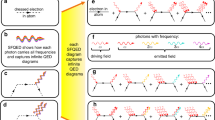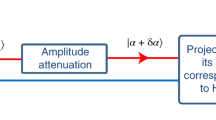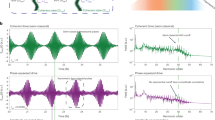Abstract
High-harmonic generation (HHG) is an extreme nonlinear process in which intense pulses of light drive matter to emit high harmonics of the driving frequency, reaching the extreme ultraviolet and X-ray spectral ranges. So far, HHG has always been generated by intense laser pulses that are well described as a classical electromagnetic field. However, the role of the quantum state of light in non-perturbative interactions of intense light with matter has remained unexplored. Here we show that the defining spectral characteristics of HHG, such as the plateau and cutoff, are sensitive to the quantum state of light. While coherent and Fock light states induce the established HHG cutoff law, thermal and squeezed states substantially surpass it, extending the cutoff compared with a coherent light state of the same intensity. Shaping the quantum state of light thus enables the production of far higher harmonics. We develop the theory of extreme nonlinear optics driven by squeezed light, and more generally by arbitrary quantum states of light, introducing the quantum state of the driving field as a degree of freedom.
This is a preview of subscription content, access via your institution
Access options
Access Nature and 54 other Nature Portfolio journals
Get Nature+, our best-value online-access subscription
$29.99 / 30 days
cancel any time
Subscribe to this journal
Receive 12 print issues and online access
$209.00 per year
only $17.42 per issue
Buy this article
- Purchase on Springer Link
- Instant access to full article PDF
Prices may be subject to local taxes which are calculated during checkout





Similar content being viewed by others
Data availability
Source data are provided with this paper. All other data that support the plots within this paper and other findings of this study are available from the corresponding author upon reasonable request.
Code availability
The code is available from the corresponding author upon reasonable request.
References
McPherson, A. et al. Studies of multiphoton production of vacuum-ultraviolet radiation in the rare gases. J. Opt. Soc. Am. B 4, 595–601 (1987).
Ferray, M. et al. Multiple-harmonic conversion of 1064 nm radiation in rare gases. J. Phys. B 21, L31–L35 (1988).
Luu, T. T. et al. Extreme-ultraviolet high-harmonic generation in liquids. Nat. Commun. 9, 3723 (2018).
Ghimire, S. et al. Observation of high-order harmonic generation in a bulk crystal. Nat. Phys. 7, 138–141 (2011).
Kfir, O. et al. Nanoscale magnetic imaging using circularly polarized high-harmonic radiation. Sci. Adv. 3, eaao4641 (2017).
Baykusheva, D., Ahsan, M. S., Lin, N. & Wörner, H. J. Bicircular high-harmonic spectroscopy reveals dynamical symmetries of atoms and molecules. Phys. Rev. Lett. 116, 123001 (2016).
Frumker, E. et al. Probing polar molecules with high harmonic spectroscopy. Phys. Rev. Lett. 109, 233904 (2012).
Neufeld, O. et al. Ultrasensitive chiral spectroscopy by dynamical symmetry breaking in high harmonic generation. Phys. Rev. X 9, 031002 (2019).
Ayuso, D. et al. Synthetic chiral light for efficient control of chiral light–matter interaction. Nat. Photon. 13, 866–871 (2019).
Heinrich, T. et al. Chiral high-harmonic generation and spectroscopy on solid surfaces using polarization-tailored strong fields. Nat. Commun. 12, 3723 (2021).
Neufeld, O. & Cohen, O. Background-free measurement of ring currents by symmetry-breaking high-harmonic spectroscopy. Phys. Rev. Lett. 123, 103202 (2019).
Luu, T. T. & Wörner, H. J. Measurement of the Berry curvature of solids using high-harmonic spectroscopy. Nat. Commun. 9, 916 (2018).
Silva, R. E. F., Jiménez-Galán, Amorim, B., Smirnova, O. & Ivanov, M. Topological strong-field physics on sub-laser-cycle timescale. Nat. Photon. 13, 849–854 (2019).
Paul, P.-M. et al. Observation of a train of attosecond pulses from high harmonic generation. Science 292, 1689–1692 (2001).
Krausz, F. & Ivanov, M. Attosecond physics. Rev. Mod. Phys. 81, 163 (2009).
Corkum, P. B. Plasma perspective on strong field multiphoton ionization. Phys. Rev. Lett. 71, 1994–1997 (1993).
Lewenstein, M., Balcou, P., Ivanov, M. Y., L’Huillier, A. & Corkum, P. B. Theory of high-harmonic generation by low-frequency laser fields. Phys. Rev. A 49, 2117–2132 (1994).
Qu, Y. & Singh, S. Photon correlation effects in second harmonic generation. Opt. Commun. 90, 111–114 (1992).
Agafonov, I. N., Chekhova, M. V. & Leuchs, G. Two-color bright squeezed vacuum. Phys. Rev. A 82, 11801 (2010).
Iskhakov, T. S., Pérez, A. M., Spasibko, K. Y., Chekhova, M. V. & Leuchs, G. Superbunched bright squeezed vacuum state. Opt. Lett. 37, 1919–1921 (2012).
Jechow, A., Seefeldt, M., Kurzke, H., Heuer, A. & Menzel, R. Enhanced two-photon excited fluorescence from imaging agents using true thermal light. Nat. Photon. 7, 973–976 (2013).
Pérez, A. M. et al. Bright squeezed-vacuum source with 1.1 spatial mode. Opt. Lett. 39, 2403–2406 (2014).
Finger, M. A., Iskhakov, T. S., Joly, N. Y., Chekhova, M. V. & Russell, P. S. J. Raman-free, noble-gas-filled photonic-crystal fiber source for ultrafast, very bright twin-beam squeezed vacuum. Phys. Rev. Lett. 115, 143602 (2015).
Sharapova, P. R. et al. Properties of bright squeezed vacuum at increasing brightness. Phys. Rev. Res. 2, 13371 (2020).
Manceau, M., Spasibko, K. Y., Leuchs, G., Filip, R. & Chekhova, M. V. Indefinite-mean pareto photon distribution from amplified quantum noise. Phys. Rev. Lett. 123, 123606 (2019).
Heckl, O. H. et al. High harmonic generation in a gas-filled hollow-core photonic crystal fiber. Appl. Phys. B 97, 369–373 (2009).
LaGattuta, K. J. Radiation emitted by a resonantly driven hydrogen atom. Phys. Rev. A 48, 666 (1993).
Gauthey, F. I., Garraway, B. M. & Knight, P. L. High harmonic generation and periodic level crossings. Phys. Rev. A 56, 3093 (1997).
Gonoskov, I. A., Tsatrafyllis, N., Kominis, I. K. & Tzallas, P. Quantum optical signatures in strong-field laser physics: infrared photon counting in high-order-harmonic generation. Sci. Rep. 6, 32821 (2016).
Tsatrafyllis, N., Kominis, I. K., Gonoskov, I. A. & Tzallas, P. High-order harmonics measured by the photon statistics of the infrared driving-field exiting the atomic medium. Nat. Commun. 8, 15170 (2017).
Bogatskaya, A., Volkova, E. & Popov, A. Spontaneous transitions in atomic system in the presence of high-intensity laser field. Europhys. Lett. 116, 14003 (2016).
Bogatskaya, A. V., Volkova, E. A. & Popov, A. M. Spontaneous emission of atoms in a strong laser field. J. Exp. Theor. Phys. 125, 587–596 (2017).
Tsatrafyllis, N. et al. Quantum optical signatures in a strong laser pulse after interaction with semiconductors. Phys. Rev. Lett. 122, 193602 (2019).
Gombköto, Á., Varró, S., Mati, P. & Földi, P. High-order harmonic generation as induced by a quantized field: phase-space picture. Phys. Rev. A 101, 13418 (2020).
Gombköto, Á., Földi, P. & Varró, S. Quantum-optical description of photon statistics and cross correlations in high-order harmonic generation. Phys. Rev. A 104, 33703 (2021).
Gorlach, A., Neufeld, O., Rivera, N., Cohen, O. & Kaminer, I. The quantum-optical nature of high harmonic generation. Nat. Commun. 11, 4598 (2020).
Varró, S. Quantum optical aspects of high-harmonic generation. Photonics. 8, 269 (2021).
Lewenstein, M. et al. Generation of optical Schrödinger cat states in intense laser–matter interactions. Nat. Phys. 17, 1104–1108 (2021).
Varró, S. Coherent and incoherent superposition of transition matrix elements of the squeezing operator. J. Phys. Conf. Ser. 2249, 12013 (2022).
Stammer, P. et al. High photon number entangled states and coherent state superposition from the extreme ultraviolet to the far infrared. Phys. Rev. Lett. 128, 123603 (2022).
Fleck, J. A., Morris, J. R. & Feit, M. D. Time-dependent propagation of high-energy laser beams through the atmosphere. Appl. Phys. 10, 129–160 (1976).
Feit, M. D., Fleck, J. A. Jr. & Steiger, A. Solution of the Schrödinger equation by a spectral method. J. Comput. Phys. 47, 412–433 (1982).
Drummond, P. D. & Gardiner, C. W. Generalised P-representations in quantum optics. J. Phys. A 13, 2353 (1980).
Kim, M. S., De Oliveira, F. A. M. & Knight, P. L. Properties of squeezed number states and squeezed thermal states. Phys. Rev. A 40, 2494–2503 (1989).
Pizzi, A., Gorlach, A., Rivera, N., Nunnenkamp, A. & Kaminer, I. Light emission from strongly driven many-body systems. Nat. Phys. https://doi.org/10.1038/s41567-022-01910-7 (2023).
Scully, M. O. & Zubairy, M. S. Quantum Optics (Cambridge Univ. Press, 1997).
Ammosov, M. V. Tunnel ionization of complex atoms and of atomic ions in an altemating electromagnetic field. Sov. Phys. JETP 64, 1191 (1987).
Leonhardt, U. & Paul, H. Measuring the Quantum State of Light. Progress in Quantum Electronics Vol. 19 (Cambridge Univ. Press, 1995).
Smirnova, O. et al. High harmonic interferometry of multi-electron dynamics in molecules. Nature 460, 972–977 (2009).
Spasibko, K. Y. et al. Multiphoton effects enhanced due to ultrafast photon-number fluctuations. Phys. Rev. Lett. 119, 223603 (2017).
Boyd, R. W. Nonlinear Optics (Academic, 2020).
Krüger, M., Lemell, C., Wachter, G., Burgdörfer, J. & Hommelhoff, P. Attosecond physics phenomena at nanometric tips. J. Phys. B 51, 172001 (2018).
Dombi, P. et al. Strong-field nano-optics. Rev. Mod. Phys. 92, 25003 (2020).
Bula, C. et al. Observation of nonlinear effects in Compton scattering. Phys. Rev. Lett. 76, 3116 (1996).
Mackenroth, F. & Di Piazza, A. Nonlinear Compton scattering in ultrashort laser pulses. Phys. Rev. A 83, 32106 (2011).
Acknowledgements
We acknowledge insightful discussions on related topics with A. Pizzi, R. Ruimy and J. Sloan. The work was supported by the Israel Science Foundation (ISF) under grant no. 830/19, by the Goldman Frontiers in Discovery Grant from the Michigan-Israel Partnership for Research and by the Helen Diller Quantum Center of Technion. The work was also partially supported by European Research Center (ERC) under the European Union’s Horizon 2020 research and innovation programme (grant no. 819440 TIMP).
Author information
Authors and Affiliations
Contributions
All authors contributed substantially to this work. A.G., M.E.T., I.K. and N.R. developed the initial theoretical ideas. A.G. and M.E.T. performed the numerical calculations. I.K., O.C., M.K., N.R. and M.B. made significant contributions in the development of theoretical concepts and ideas. I.K. and O.C. supervised the project.
Corresponding author
Ethics declarations
Competing interests
The authors declare no competing interests.
Peer review
Peer review information
Nature Physics thanks the anonymous reviewers for their contribution to the peer review of this work.
Additional information
Publisher’s note Springer Nature remains neutral with regard to jurisdictional claims in published maps and institutional affiliations.
Supplementary information
Supplementary Information
Supplementary Figs. 1–9, Tables 1–3 and derivations of all of the equations.
Source data
Source Data Figs. 3 and 5
Unprocessed versions of Figs. 3 and 5 in .fig and .mat formats.
Rights and permissions
Springer Nature or its licensor (e.g. a society or other partner) holds exclusive rights to this article under a publishing agreement with the author(s) or other rightsholder(s); author self-archiving of the accepted manuscript version of this article is solely governed by the terms of such publishing agreement and applicable law.
About this article
Cite this article
Gorlach, A., Tzur, M.E., Birk, M. et al. High-harmonic generation driven by quantum light. Nat. Phys. 19, 1689–1696 (2023). https://doi.org/10.1038/s41567-023-02127-y
Received:
Accepted:
Published:
Issue Date:
DOI: https://doi.org/10.1038/s41567-023-02127-y
This article is cited by
-
Motion of charged particles in bright squeezed vacuum
Light: Science & Applications (2024)
-
Multiphoton electron emission with non-classical light
Nature Physics (2024)
-
Quantum optics meets attosecond science
Nature Physics (2023)



